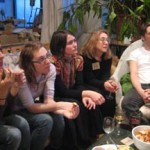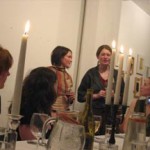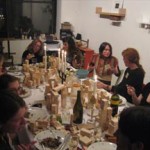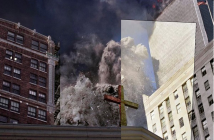On Friday, April 12th, The Berwick Research Institute hosted a dinner at the studio of artist Jill Slosburg-Ackerman in Somerville. The purpose of the dinner was to discuss the state of public art in Boston, and the conversation was led by Meg Rotzel and Susan Sakash, co-directors of the Berwick’s Public Art Incubator Program. Present for the conversation were Matthew Hincman, Nova Benway, Hannah Burr, Sarah King McKeon, Lauren Johnston, Ellen Driscoll, Laurel Demarco, Marissa Molinaro, and myself.
The conversation was very lively all evening long, driven by ever-changing courses of food, and a small table game that involved placing wooden blocks on the table whose rules changed with each course. The Berwick has a long history of merging talk of art with good food, and they were in fine form this evening.
A summary of the evening’s discussion would be way to long to print here, but some key issues arose that pointed to some directions in which artists could focus their energy, and where the Berwick might support these efforts. Areas of interest included a stronger working relationship with the cities of Boston, Cambridge and Somerville, and finding ways to change the discourse around who creates and implements public works.
Matthew Hincman, a sculptor noted for his excellent luck last year in having a guerilla project become city-sanctioned, spoke about how hard it can be to include an artist in public art. He pointed to the community-driven nature of the funding process, and how (through teaching at MassArt) he has been involved in creating public work with community groups. More often than not, he said, if the project was to be led by an artist rather than the result of community effort, it would get cancelled or under-funded.
Much of the focus of the conversation focused on what is expected of public art. This, of course, was a lively and interesting discussion, especially since the Berwick is noted for their conceptually and socially progressive public art works, and the history of the Public Art Incubator Program to date boasts three exceptional, non-permanent projects: The Institute For Infinitely Small Things’“Corporate Commands” project, working with a community group in Dudley Square; Matthew Mazzotta and Heather Clark's Busycle; and John Ewing’s “Virtual Street Corners” project.
The expectations of public art vary from person to person, and context to context. That was not surprising. What was a bit unexpected, though, was how diverse our little group was, and how heated conversation became when defining work that was inside or outside the type of discourse we expected from art. Add to that the general public’s expectation of utility or practicality, and the field of options grew too large to manage. Even the definition of “public” came under scrutiny, because that word, along with “community,” have become generic terms within arts funding groups and do not point to specific concerns that art can address or people who will experience the work.
It would be unfair to say that any conclusions were reached by the time dessert arrived, but a general consensus was reached on a few points. Most importantly, it was obvious that the Berwick’s role in supporting public art would come through very specific projects, and probably projects outside the general expectations of public art. Since this was already happening, it was considered what and how to pursue the current agenda, and where new artists might find their way to the Berwick for support. The ultimate success of the Berwick’s public art programming will come from a mixture of motivated artists and strategic planning.
The other major conclusion was that the language of public art is in serious disarray, and that the very term is so convoluted as to have little meaning. If artists can clarify their expectations about what they expect from art that happens “in the public” – or even define where the private ends and the public begins – then there is hope for shifting the attitudes of funding agencies and government to accommodate more artist-driven public work.
This “Meet Me At The Table” dinner was the first of several planned by the Berwick. The next conversation will take place on Friday, May 25th, 2007 at Art Interactive. If you would like to attend, contact the Berwick at their “Meet Me At The Table” website.
- Three views of the first Meet Me At The Table dinner.
All images are courtesy of the author.





